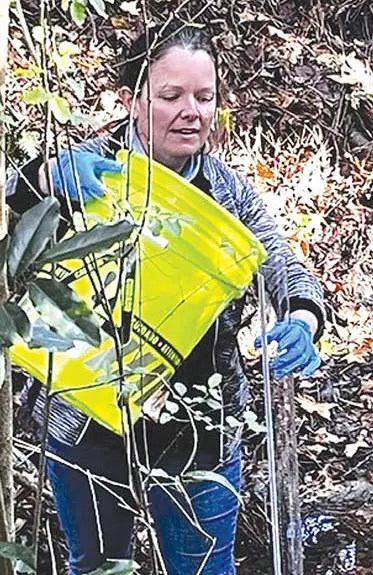
Mike Cox
Jan 18, 2024
Bailey Slice Parker, executive director of the Gills Creek Watershed Association, pulled into the Cutler School parking lot at the same time as this reporter. We were trying once again to get the water test completed in the creek that is a large part of Cutler’s educational curriculum.
As we chatted briefly about banjoes and what not, a Gills Creek Association intern named Courtney Rucker pulled in beside us. This test was originally scheduled for November 21 but was rained out. Too much water dilutes the test results. So here we were, two scientists, and one creaky old reporter soon to be joined by two schoolteachers and 11 students, all wearing galoshes on Tuesday, November 28.
The covered study area was cold in the midmorning, surrounded by trees and still damp soil. It appeared to a veteran of dealing with kids that the students would soon lose interest in anything educational as exposure encouraged more moving around and less quiet reflection. But these weren’t ordinary students—and definitely not ordinary teachers.

Courtney Rucker tests water samples.
Mrs. Val, as Dr. Valerie Hoyt-Parrish is locally known, teaches fourth and fifth grade students with the confidence of a veteran educator, the control of a drill instructor, and the excitement of a first-year kindergarten aid. Her sidekick, Robin Lourie, was also in total control but in a slightly quieter way.
The water test conducted by Master Naturalist Parker and assistant Rucker was the one found at www.clemson.edu/public/watershed/scaas/index.html, which is dictated by the S.C. Adopt-A-Stream program.
Samples are collected and tested for four particular parameters: 1. Transparency; 2. pH level (whether the sample is neutral, basic, or acidic); 3. Dissolved oxygen; and 4. Bacteria. Findings are reported to the Adopt-A-Stream database, run by Clemson University in partnership with DHEC.
These citizen science findings serve to set a baseline of expected conditions so it’s easier to tell when something changes. If bacteria is particularly high, or dissolved oxygen particularly low, the site is flagged and DHEC will follow up to try and find the cause.
In the case of Cutler’s outside classroom stream, another step is required. Past testing verified that bacteria (E. coli, specifically) is high, but knowing the source is required so the solution can be tailored to fit the cause. A lab—jonahventures.com—that specializes in Microbial Source Tracking has been contacted. It is sending a kit to collect a sample of the Cutler creek water to test the DNA of the Cutler E. coli and determine whether the source of the bacteria is human, canine, wild, or livestock. The results will determine what steps are needed to fix the problem.
The testing procedure from a novice viewpoint involved adding a few measured drops of chemicals to a sample, letting the sample settle, adding other chemicals, and then measuring what was left, followed by an insertion of another chemical that wiped away all evidence of chemical reaction.
This last step was calculated by measuring what a syringe looked like after drawing water out. The one head spinning wildly and unable to keep up with what was going on kept his mouth shut except when opened in scientific wonder. Everyone else seemed to know the plot and understood what was next.
Each step was captured in a waste container after test results were documented and the testing vehicles were thoroughly cleaned. After results were completed, the entire work area, including all pieces of equipment used, were scrubbed.
The students then raced excitedly toward the warm interior of their indoor classroom, followed by teachers and Gills Creek dignitaries. This reporter was really glad one of the few things in good working order on his ancient Highlander was the heater—and wished he’d owned a pair of cool galoshes like everyone else.
Again: Stay tuned— this is an ongoing story.
